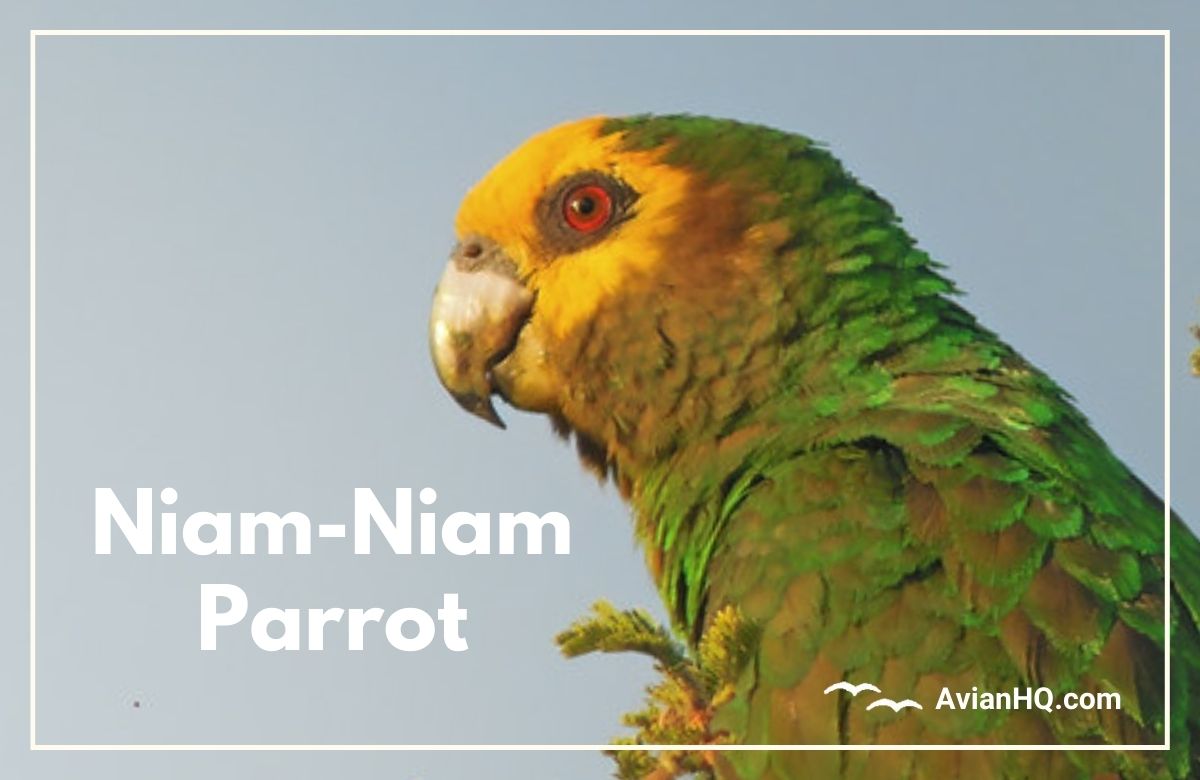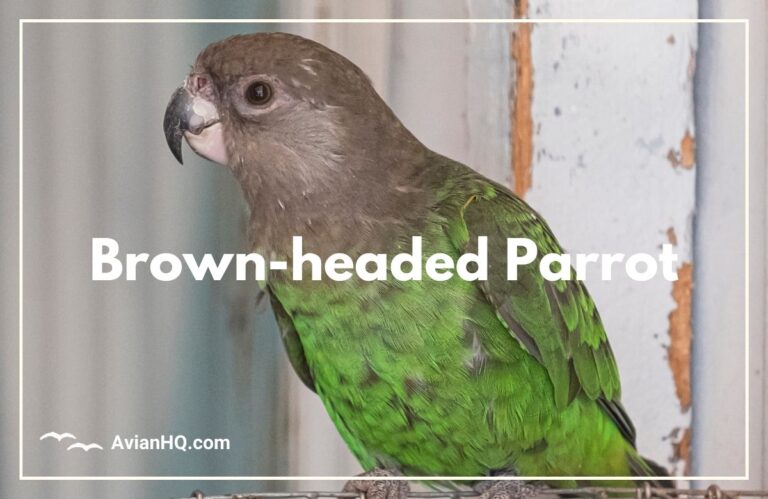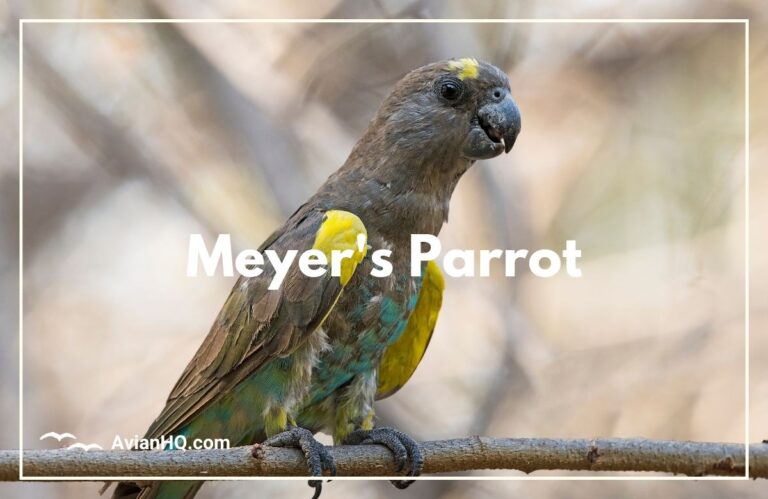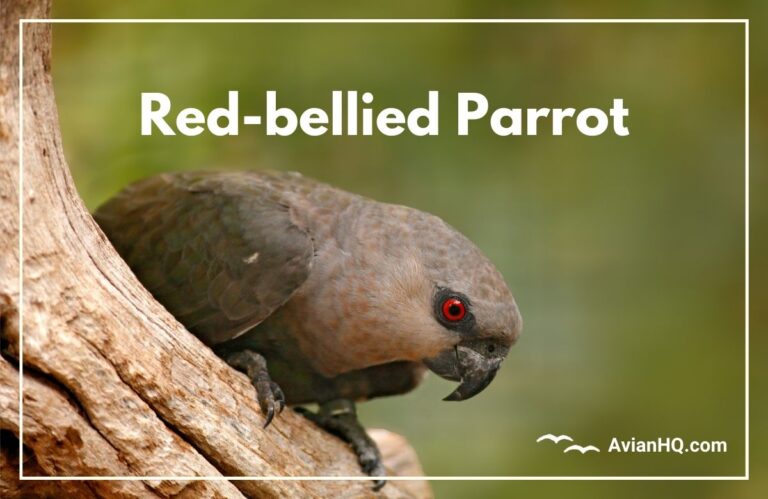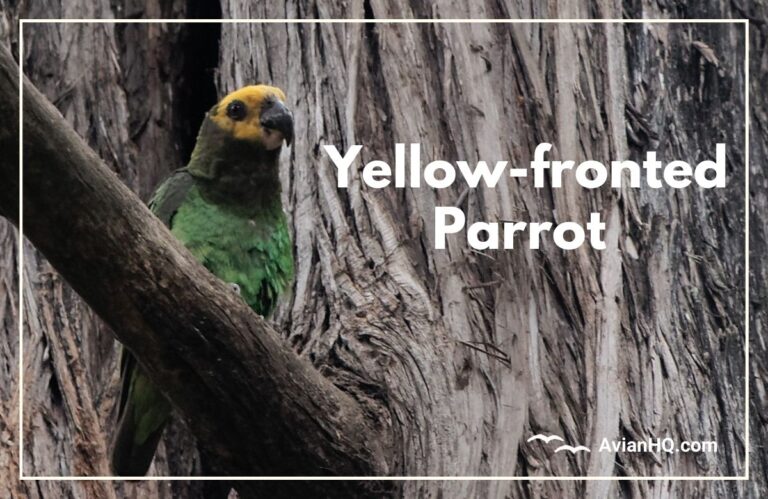Niam-Niam Parrot (Poicephalus crassus)
Have you ever seen a mostly green parrot with a greyish-brown head and bright orange eyes? If so, you may have spotted the Niam-Niam Parrot (Poicephalus crassus), one of Africa’s most elusive and least-known parrot species.
These striking birds stand out with their unique coloration and sharp calls that carry over long distances. But despite their vocal tendencies, Niam-Niam Parrots have kept many secrets from human researchers so far. Their secluded existence in the forests and savannas of Central Africa has made them a rare sight and challenging subject of study.
Niam-Niam Parrots belong to the genus Poicephalus, which contains other African parrots like the famous Senegal Parrot. But what sets them apart is how little we understand about them compared to their close cousins. These parrots weren’t even photographed until 2017 and major gaps remain about their life histories, conservation needs, and even taxonomic status.
So join us on an exploration into the captivating world of Poicephalus crassus! We’ll cover everything from physical traits to feeding, breeding, ecology, and conservation efforts across their range in the Congo Basin. With more field studies and tracking of wild populations underway, the outlook is bright for unraveling more of the mysteries around these Central African avian jewels.
History and Discovery
The Niam-Niam Parrot has managed to stay out of sight and largely undocumented for most of modern ornithological history. These birds reside in the remote wilds of mainland Equatorial Africa, which hindered their discovery by Western science until fairly recently.
First Sightings
The local name “Niam-Niam” gives a clue to the parrot’s obscurity, as it likely derives from a Central African tribal language unfamiliar to European colonists and naturalists. Most accounts suggest the eminent German zoologist Anton Reichenow made the first formal description of these parrots in print around 1900. But their existence likely had been known to native groups for centuries before entering the annals of Western biology.
Scientific Naming
The genus name Poicephalus translates to “thick-head,” reflecting a defining trait of these parrots. The species name crassus similarly labels them as “stout” or “stocky.” So the full scientific name marks them as the robust, thick-headed parrots of the Congo Basin woodlands.
As Reichenow originated the name, credit goes to him as the taxonomic authority, with the full scientific name written as Poicephalus crassus Reichenow. No identifiable subspecies are distinguished within the group at this time.
Recent Rediscovery
After Reichenow’s initial series of specimens, the Niam-Niam Parrots faded back into obscurity for decades. Not until 2017 did modern documentation occur, when photographer Jerome Fuchs captured the long-awaited first photos of these birds in the wild. This triumph came over 100 years since scientists had first described the species! With new technologies like camera traps and satellite tracking coming into play, more discoveries surely lie ahead to fill the knowledge gaps around this elusive creature.
Physical Appearance
The Niam-Niam Parrot cuts a striking figure in the African forests where it dwells. Standing around 25 centimeters (9.8 inches) tall, it’s bright plumage and unique markings make it easily recognizable among other parrot species.
Size and Weight
Average measurements show these compact parrots reaching just over 9 inches in height amidst an overall stocky body plan. No weight statistics have been reliably recorded from wild birds, but the sturdy build suggests a proportionally heavy parrot of likely 10 ounces or more.
Plumage and Markings
From head to tail, the Niam-Niam Parrot bears a vivid palette of colors. The forehead, crown, nape and cheeks present as solid greyish-brown, contrasting the predominant green hues. The throat and upper breast also wear this grey-brown coloration.
Rich green fills out the lower breast, belly, back, wings, and tail. Underwing flight feathers show deep blue on the outer webs. The short blunt tail exhibits dull olive-brown central feathers bookended by brighter green at the lateral edges.
Other notable markings come in the form of silver-tinged grey ear coverts, orange irises, and a pale blue-gray upper mandible tipped in black. The stubby lower beak matches the yellow eyerings encircling the fierce orange eyes. Grey feet complete the look.
Gender Differences
No reliable documentation yet confirms any differences in appearance between male and female Niam-Niam Parrots. Like many parrots, establishing gender may only be possible through DNA testing, surgical examination, or observing mating behaviors. Both sexes appear to share the same vibrant palette of greens, grey, and yellow markings.
Habitat and Distribution
The Niam-Niam Parrot resides in the lowland tropical forests and wooded grasslands of Central Africa’s Congo Basin. It’s range spans across Cameroon, the Central African Republic, Chad, Sudan and the Democratic Republic of Congo.
Native Habitat
These parrots occupy a variety of habitats across their distribution. Open woodlands, moist gallery forests, forest-savanna mosaics, and riparian corridors likely hold the highest densities in terrain up to 3,300 feet (1,000 meters) in elevation. They require old stands of trees for roosting and nesting within their wide-ranging territory.
Range and Distribution
Niam-Niam parrots congregate primarily in the Central African Republic, which sits at the center of their expansive range. From here, smaller numbers reach out into surrounding countries—south and east into DRC and Sudan, west into Cameroon and Chad.
Their total geographic distribution stretches for over 1,240 miles (2,000 km) across Central Africa. It spans an area measuring approximately 620,000 square miles (1.6 million square km), though not uniformly. Their scarcity makes conservation surveys difficult, obscuring exactly how abundant or dispersed the population might be.
Introduced Populations
No introduced or invasive populations of Niam-Niam Parrots exist outside of their native Central African habitat. Trade as pets or captive breeding for export does not play a major role for this species. Their shy behavior likely reduces their appeal compared to other parrot varieties more accustomed to human environments. For now, they appear content within the Congo Basin woodlands they have inhabited for centuries past.
Diet and Feeding
As with most parrots, Niam-Niam Parrots eat a wide mix of foods. Their large powerful beaks allow them to crack hard nuts and seeds which form a primary part of their diet. They supplement this with soft fruits, berries, vegetation, and occasional protein from insects or small creatures.
Natural Diet
The bulk of their calories comes from oils and carbohydrates in hard-shelled nuts and seeds. Favored items include palm nuts, pine nuts, acacia pods, maize, millet, and cereal grains. Walnuts and other tree crops also contribute.
Fruit brings vital nutrients, especially when native figs, mangos, plums and berries ripen into sweet soft treats. Leafy matter and edible blossoms add variety. And snails, insects, small vertebrates or eggs make rare but precious sources of protein.
Feeding Behaviors
Their strong jaws enable cracking unripe nuts and dismantling large, woody seed pods other birds cannot access. This lets them take advantage of abundant foods often overlooked within their habitat. They employ their clawed feet to grasp and manipulate choice morsels.
While they seem to forage primarily in trees, these parrots sometimes descend to fields for fallen grain or ground tubers. Generally they roam the canopy solo or in pairs working methodically through a territory over the course of a day. Their powerful beaks make short work of most any plant matter or protective shell they encounter.
Breeding and Reproduction
Many aspects of breeding and reproduction in Niam-Niam Parrots remain shrouded in mystery. These private birds nest in remote tree hollows deep within the African rainforests, evading detection. But observations of related species provide clues into their reproductive habits.
Nesting Sites
Niam-niam Parrots require large, old trees with cavities for nesting places. The females likely choose holes formed by decay in living trees or those vacated by woodpeckers. The nest chambers occupy a cool, dark, relatively secure site protected from predators and the elements.
Clutch Size
In related Poicephalus parrots, average clutch size ranges between 3-5 eggs. Niam-Niam Parrots likely fall within or slightly above that range. The female develops and lays the eggs over intervals of 2-4 days. She then incubates them while the male provides most of her food.
Incubation Period
The incubation phase lasts approximately 30 days from the laying of the last egg until all the chicks hatch. Some variability occurs based on species and conditions. Upon hatching, the young parrots are blind, naked and helpless.
Fledging Age
The chicks remain in the nest where they grow protective down, open their eyes, stand and stretch their wings over the first several weeks. Around 9-12 weeks from hatching, the fledglings develop enough to emerge from the nest cavity and take their first flights. However, they may still associate with their parents for an additional period as they perfect survival skills.
Brooding nest sites high in the forest canopy help protect the vulnerable young parrots. But many unknowns remain around the reproduction of this rare African species.
Behavior and Ecology
The remote habitat and evasive nature of Niam-Niam Parrots limit direct observations of their behavior in the wild. But field encounters and knowledge of related species provide provisional insights.
Social Dynamics
Niam-niam Parrots typically appear in pairs or small family groups rather than large flocks. The mating pair forms the central social unit, sharing a territory for nesting and foraging. Their offspring may remain nearby for an extended period before dispersing to establish new territories.
Roosting and Rest
These parrots sleep in tree cavities away from ground-based threats. Their stout builds allow them to wedge firmly and sleep soundly on a branch or within a hollow nightly. At dawn, calls between pairs or group members help coordinate the start to daily activity.
Foraging and Feeding
The morning and late afternoon bring peak foraging times. Using their strong beaks and feet, they can extract and process foods unavailable to other fauna. Though messy eaters, dropping debris below their arboreal dining tables. They cover territory methodically in search of fruiting trees and heavy seed pods.
Interactions with Other Species
Little has been documented regarding relationships with other animals. Their size and powerful bite likely deters potential nest competitors. But they ultimately occupy an innocuous niche feeding almost strictly on plant matter within the intact Central African ecosystems they inhabit. More threats likely come from logging, agriculture and aridification decreasing their preferred forest habitats over time.
Conservation Status
The isolated nature and small remaining habitat of Niam-Niam Parrots raises conservation concerns. However their scarcity also makes assessing current population trends difficult. More data is needed.
IUCN Red List Status
As of 2020, the IUCN Red List classifies Niam-Niam Parrots as Least Concern. But it notes the population size has actually never been quantified or monitored with certainty. Their perceived rarity and restriction to small fragmented habitats still poses potential long-term risks.
Population Numbers
Without systematic surveys, any total population estimates remain crude guesses at best. Fewer than 50 documented sightings may exist. One 2007 study suggested 10,000-25,000 individuals, but admitted this was largely hypothetical extrapolation. Getting actual population metrics is an urgent need.
Major Threats
The thinly dispersed groups show an ability to utilize marginal savannas and ecotone forests avoided by most birds. This confers some resilience as Central Africa faces ongoing issues of deforestation, agricultural expansion and climatic changes. However, their specialized arboreal niche still declines wherever extensive canopy loss occurs. Direct capture for pets may pose minimal additional threats presently.
Protection Efforts
Parts of their range fall within existing national parks and protected areas like Manovo-Gounda-St.Floris National Park. But more wildlife corridors maintaining old-growth trees are essential for connecting fragmented groups across the landscape. Expanding reserves and discouraging clear-cut logging of keystone tree stands could sustain viable habitat for these vulnerable parrots. International cooperation through accords like CITES can limit any potential poaching or smuggling as well.
With sound stewardship of Central Africa’s remaining rainforests, the outlook improves for preserving robust populations. But filling knowledge gaps through pronounced field studies remains a key step toward firming up their uncertain conservation status.
Cultural Significance
As one of Africa’s most obscure parrots, the Niam-Niam Parrot has minimal recognized cultural importance currently. Their remote range lacks widespread integration into human legends or commerce. But potential exists for more prominent cultural roles in the future.
Local Tribal Significance
The onomatopoeic native name “Niam-Niam” hints at mimicry of these birds’ distinctive calls. Local tribes were likely the first to note and baptize the species even before Western science documented them. Their bonds could run deeper as mutual denizens of Africa’s forests. Outreach to include indigenous ecological knowledge may reveal deeper cultural views.
Captive Appeal
Few examples of captive Niam-Niam Parrots exist globally. Their wariness toward humans coupled with remote source regions limits trade exploitation so far. Those kept as pets tend to be rescued birds needing rehabilitation back to the wild. But if sustainable captive breeding developed, public demand could possibly grow for such a rare green “thick head” in the global pet trade.
Ecotourism Potential
In protected reserves like Manovo-Gounda-St.Floris National Park, birdwatching tourists would relish sighting these uncommon parrots in their native habitat. Safari guides could make special excursions off common circuits to give visitors the thrill. And local economies could benefit from associated fees or handicrafts celebrating the alluring species. Such programs must ensure proper protections to avoid disrupting sensitive areas however.
The potential clearly exists for mutually positive relationships between human and avian inhabitants sharing the Congo Basin’s spectacular biodiversity. Pursued conscientiously, these could significantly raise both ecological and cultural esteem for the Niam-Niam Parrot worldwide.
Conclusion
The Niam-Niam Parrot remains one of Africa’s most mystifying birds. It’s remote wetland habitat and evasive behavior have made it a major challenge just to observe and document basic natural history. Many aspects of diet, social patterns, reproduction, conservation status and even population numbers stay frustratingly vague.
Yet their charming appearance and boisterous calls beckon further insight sure to better captivate the public. Unlocking secrets of these little-known parrots promises to enlighten scientific knowledge and amplify environmental awareness for the Congo Basin at large.
Recent rediscoveries after decades without sightings should reinvigorate research campaigns to fill information gaps. New tracking technologies and camera traps offer advanced means to remotely monitor wild populations. Bolstered protected area networks could secure essential forest habitat against hunting, land conversion and resource extraction. And smarter climate change mitigation can help maintain ecosystems hospitable for the species.
The outlook shines brightly thanks to 21st century tools for overcoming past obstacles to understanding. What we learn promises to amaze as Niam-Niam Parrots surrender more of their obscure existence to human discovery. It depends on the passion and patience of conservation communities to patiently unveil those revelations in coming years.

